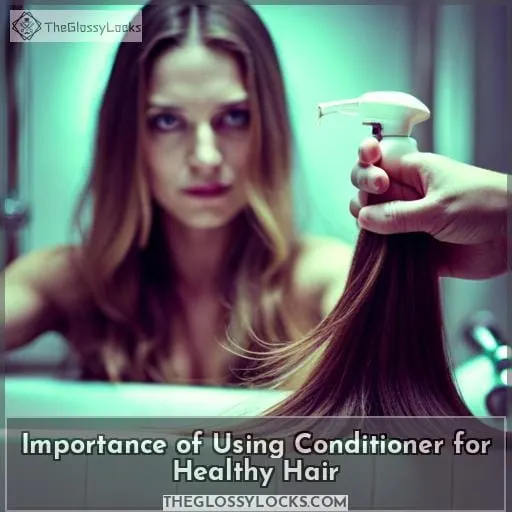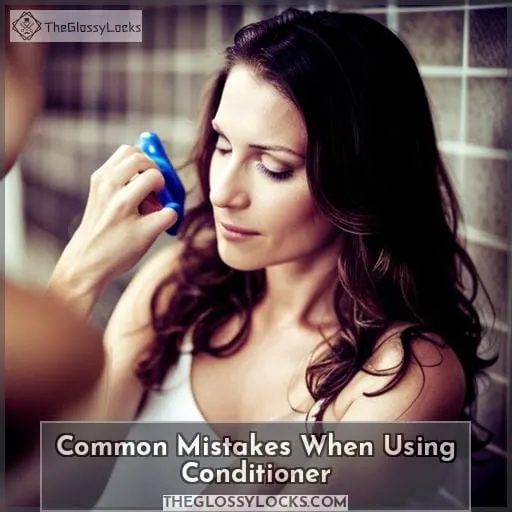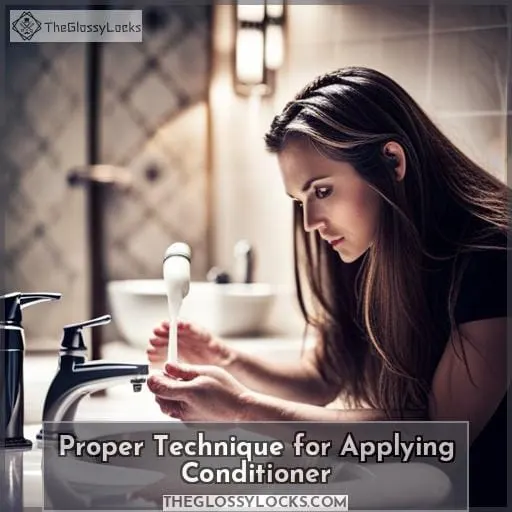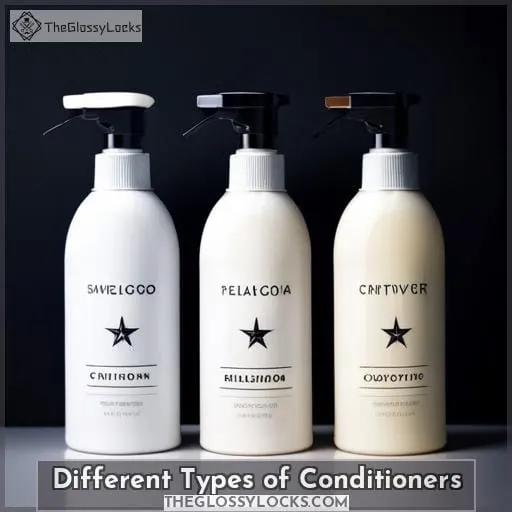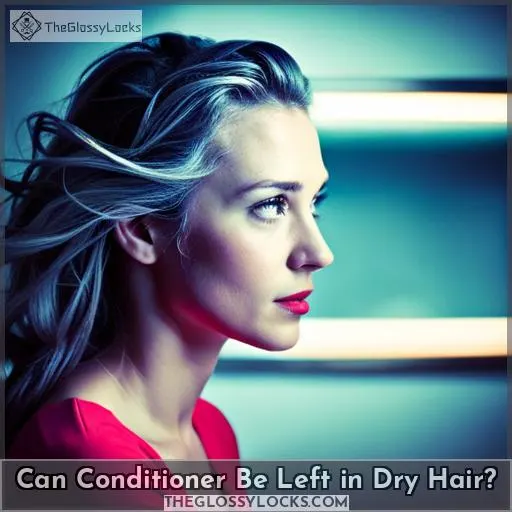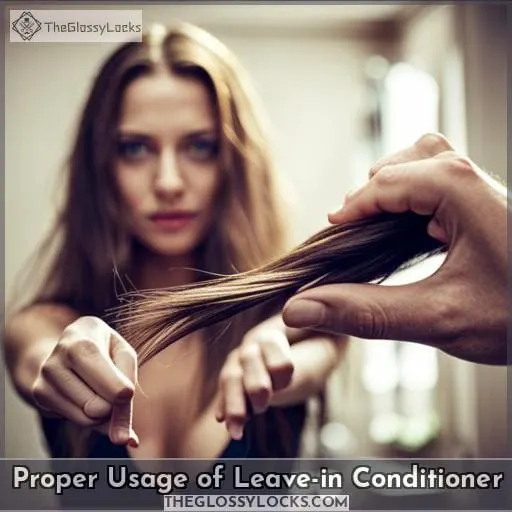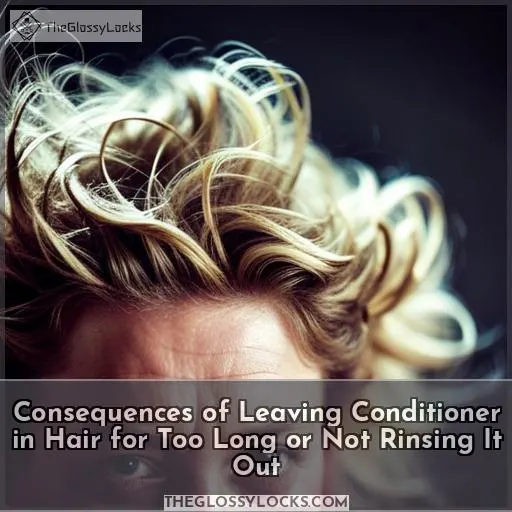This site is supported by our readers. We may earn a commission, at no cost to you, if you purchase through links.

Did you know that leaving it on too long can weigh down your hair or make it feel oily? Experts recommend following the directions on the bottle, typically leaving conditioner in for 2 to 3 minutes.
Avoid common mistakes like using too much or applying from root to tip. Find out more about proper technique and different types of conditioners as we dive into expert tips for healthy, manageable hair.
Table Of Contents
- Key Takeaways
- Importance of Using Conditioner for Healthy Hair
- Common Mistakes When Using Conditioner
- Proper Technique for Applying Conditioner
- Can Conditioner Be Used Before or After Shampoo?
- Different Types of Conditioners
- How Long Should Rinse-out Conditioner Be Left in Hair?
- How Long Should Deep Conditioner Be Left in Hair?
- Can Conditioner Be Left in Dry Hair?
- Proper Usage of Leave-in Conditioner
- Consequences of Leaving Conditioner in Hair for Too Long or Not Rinsing It Out
- Frequently Asked Questions (FAQs)
- Conclusion
Key Takeaways
- Rinse-out conditioner should be left in the hair for 1-2 minutes for fine or oily hair, 3-5 minutes for dry, damaged, or curly hair, and up to 10 minutes for a deeper treatment.
- Deep conditioner should be left in the hair for 5-10 minutes for best results.
- Conditioner can be used on dry hair to add moisture, focusing on the ends rather than the roots.
- Leaving rinse-out conditioner in the hair overnight is not recommended.
Importance of Using Conditioner for Healthy Hair
Using conditioner is essential for maintaining the health and vitality of your hair.
- Preventing frizz
- Detangling hair
- Adding shine
- Preventing breakage
- Repairing damage
Conditioner works by nourishing and moisturizing your strands from root to tip. It helps to seal the cuticles of your hair shafts, which prevents moisture loss and protects against environmental damage.
Regular use of a good-quality conditioner can improve the overall condition of your locks over time. Not only does it make your hair more manageable and easier to style but it also enhances its natural beauty by making it look healthier and shinier.
Make sure you choose a suitable conditioner for your specific hair type in order to maximize its effectiveness in keeping your locks healthy.
Common Mistakes When Using Conditioner
When it comes to using conditioner, there are a few common mistakes you should avoid.
- Applying conditioner from root to tip can weigh your hair down and make it look greasy.
- Not leaving the conditioner on long enough or using too much or too little can also impact its effectiveness.
- Lastly, inconsistency in conditioning by skipping it altogether or not conditioning regularly can lead to dry and damaged hair.
Applying From Root to Tip
One common mistake people make when using conditioner is applying it from root to tip.
- Applying conditioner from root to tip can weigh down your hair
- Weighed down hair may appear greasy
- Conditioner should be applied only on the ends of the hair
- Proper application ensures that each strand receives adequate moisture
Not Leaving It on Long Enough
To ensure maximum effectiveness, you should leave conditioner in your hair for the recommended 3-5 minutes.
Leaving it on too short can result in dry and frizzy hair.
| Mistake | Consequence | Solution |
|---|---|---|
| Not leaving conditioner long enough | Dry and frizzy hair | Follow instructions and leave it on for the recommended time |
Using Too Much or Too Little
Don’t make the mistake of over or underestimating the amount of conditioner you use on your hair. Using too much or too little can affect its effectiveness and leave your hair looking dull, greasy, or tangled.
Finding the right balance for your specific hair type is crucial. Consider factors such as texture, porosity, density, and oiliness when determining how much conditioner to use.
- Using too little may not provide enough hydration and nourishment for your locks.
- On the other hand, using an excessive amount can weigh down your hair and make it appear oily.
Inconsistency in Conditioning
When using conditioner, it’s important to avoid inconsistency in conditioning your hair. This means being consistent with daily or weekly conditioning and choosing the right conditioner for your hair type.
| Common Mistakes When Using Conditioner |
|---|
| Not Conditioning Regularly |
| Using Wrong Conditioner for Hair Type |
Inconsistency in conditioning can lead to dryness, frizz, and damage. Make sure to condition regularly and use the appropriate conditioner for your specific needs such as curly hair or colored hair.
Proper Technique for Applying Conditioner
After shampooing,
- Apply conditioner from mid-length to ends,
- Gently detangle hair,
- Allow the conditioner to sit for 1-3 minutes,
- Rinse thoroughly.
Leaving conditioner on too briefly prevents it from adequately moisturizing, while leaving it on too long can weigh hair down.
Follow these simple steps of washing, conditioning, detangling, sitting, and rinsing to properly condition hair.
Washing Hair With Shampoo
Before applying conditioner, you’re washing your hair thoroughly with shampoo. This step is crucial for removing dirt, oil, and product buildup from your hair and scalp.
Applying Conditioner
Apply conditioner to your hair after washing it with shampoo.
- Focus on mid-lengths and ends
- Use a coin-sized amount
- Smooth through hair
Detangling Hair
To properly detangle your hair while applying conditioner, gently comb through the strands with a wide-toothed comb or your fingers.
Detangling Tips:
- Use a wide-tooth comb or fingers for gentle detangling.
- Prevents breakage and damage to the hair strands.
Allowing It to Sit
After detangling your hair, you’ll want to let the conditioner sit for 1-3 minutes. This allows the conditioner to penetrate the hair shaft without overloading. Then, rinse thoroughly with warm water.
- Softening strands
- Moisturizing mid-lengths
- Nourishing ends
Rinsing With Warm Water
After allowing the conditioner to sit in your hair for the recommended time, rinse it out thoroughly with warm water.
Warm Water:
- Helps open up the hair cuticles
- Allows conditioner to penetrate deeply
- Enhances blood circulation in scalp
- Promotes healthy hair growth
Can Conditioner Be Used Before or After Shampoo?
You may be wondering whether it’s better to use conditioner before or after shampooing your hair.
Using conditioner before shampooing creates a protective barrier that prevents the harsh detergents in shampoo from over-stripping your hair.
Using conditioner after shampooing helps restore moisture, smooth down the cuticle, and improve manageability.
Conditioner before shampooing is ideal for very dry or curly hair. Using it after is best for fine, oily hair.
Using other treatments like masks, oils, or heat protectants depends on your hair’s specific needs.
Different Types of Conditioners
When deciding how long to leave conditioner in, it’s crucial to consider the type of conditioner you’re using.
Popular options include:
- Rinse-out
- Leave-in
- Deep conditioning treatments
- Cleansing conditioners
Each requiring different processing times.
Understanding these key differences will ensure you achieve maximum conditioning benefits tailored to your hair’s needs.
Rinse-out Conditioner
One type of conditioner that must be thoroughly rinsed out of hair is rinse-out conditioner.
It moisturizes hair without leaving residue.
Apply after shampooing, focusing on midshaft to ends.
Leave on 1-5 minutes depending on hair type.
Rinse thoroughly with cool water.
Types include daily, weekly, color-safe.
Leave-in Conditioner
Among the conditioner types is leave-in conditioner, which you’re applying without rinsing from damp hair for continued hydration.
Pros and cons of leave-in conditioners include:
- easy application
- prolonged moisture
- potential for product buildup.
Deep Conditioner
With deep conditioner, you’re wanting to penetrate the hair shaft more deeply in order to restore hair health.
Deep conditioner is great for dry, curly, damaged, and frizzy hair types.
Cleansing Conditioner
To properly understand how long to leave conditioner in your hair, it’s important to explore the different types of conditioners available, including cleansing conditioner.
Cleansing conditioners gently cleanse hair of buildup while moisturizing, unlike clarifying shampoos. Follow directions when using one, as overuse can cause greasy hair or skin irritation.
How Long Should Rinse-out Conditioner Be Left in Hair?
After detailing the different types of conditioners, you’d want to know how long a rinse-out conditioner should stay on your hair before rinsing.
For most hair types, it’s recommended to leave a rinse-out conditioner in for:
- 1-2 minutes for fine or oily hair – Any longer can weigh down fine hair or make oily hair look greasy.
- 3-5 minutes for dry, damaged, or curly hair – More time allows deeper conditioning to hydrate and nourish these hair types.
- Up to 10 minutes for a deeper treatment if your hair is extremely dry or damaged – But rinse out thoroughly after.
Leaving it on any longer doesn’t provide much extra benefit and may cause buildup. Follow the conditioner directions and adjust timing as needed based on your hair’s condition.
How Long Should Deep Conditioner Be Left in Hair?
You’d want to leave a deep conditioner in your hair for 5-10 minutes for best results.
Deep conditioners are formulated to deeply penetrate the hair cuticle and provide intense moisture to dry, damaged hair.
- Hair porosity: Deep conditioners work well for all types of porosity, whether you have low, medium, or high porosity hair.
- Hair texture: Regardless of whether you have straight, wavy, curly or coily hair texture; deep conditioning is beneficial as it helps moisturize and nourish each strand.
Remember not to exceed the recommended time frame when leaving a deep conditioner in your hair.
Can Conditioner Be Left in Dry Hair?
If you have dry hair, you should regularly leave conditioner in your hair for at least a few minutes after showering to help restore moisture and improve its overall condition.
Leaving conditioner in dry hair can provide multiple benefits. It helps replenish lost moisture, leading to improved softness, manageability and shine. Additionally, ingredients like fatty alcohols and cationic surfactants in conditioners help smooth down the cuticle layer of hair, reducing frizz and flyaways.
This also helps prevent further hair damage and split ends by protecting the hair shaft.
However, be mindful not to over-condition to avoid product buildup that could leave hair looking limp and greasy over time. Finding the right balance is key for getting the most out of conditioner without weighing dry hair down.
Proper Usage of Leave-in Conditioner
Leave-in conditioners provide continued hydration and protection for your hair after washing.
When using a leave-in, apply a small amount to towel-dried hair, focusing on the mid-lengths and ends.
These lightweight formulas can be used daily, providing a boost of moisture to parched strands.
Tailor leave-in use to your hair’s needs—fine hair may only require application a few times per week to avoid residue buildup.
Those with thick or curly locks prone to dryness can use a leave-in more frequently for manageability and softness.
Experiment to find your ideal leave-in to maximize the benefits for your hair type.
Consequences of Leaving Conditioner in Hair for Too Long or Not Rinsing It Out
Several unwanted consequences await when leaving conditioner in your hair too long or neglecting to rinse it out completely.
- Over-conditioned hair can become:
- Dry and brittle from being stripped of natural oils
- Weighed down and greasy from product buildup
- Prone to split ends from poor moisture balance
- Hair never properly rinsed of conditioner residues risks looking perpetually dirty and dull.
- Scalp irritation arises over time from clogged follicles and pores.
Fully rinsing after proper conditioning duration keeps hair supple and shiny. Letting conditioner overstay its welcome or accumulate brings preventable damage.
Frequently Asked Questions (FAQs)
Can I use conditioner on dry hair?
Yes, you can use conditioner on dry hair to add moisture.
Focus conditioner on the ends rather than the roots to avoid greasiness.
Let it soak for a few minutes before rinsing.
Using conditioner on dry hair can help restore smoothness and shine between washes.
Is it necessary to use a leave-in conditioner?
While an additional layer of moisture can be helpful, leave-in conditioners aren’t strictly necessary for most.
Focus first on finding a good rinse-out conditioner that addresses your hair’s needs.
If extra hydration is still desired, experiment with leave-ins to see if they make a positive difference without weighing hair down.
How often should I deep condition my hair?
Deep condition your hair once a week for best results.
- Apply a nourishing hair mask.
- Put on a shower cap.
- Let it soak in for 10-30 minutes.
- Rinse thoroughly.
This intensive treatment replenishes moisture and repairs damage without overconditioning.
Can I use conditioner before shampooing?
Yes, you can use conditioner before shampooing.
Pre-conditioning creates a protective barrier, allowing shampoo to cleanse without completely stripping hair.
Leaving conditioner on too long risks weighing down strands; aim for 1-2 minutes max.
Then shampoo as usual.
Can I leave my rinse-out conditioner in my hair overnight?
Leaving rinse-out conditioner in your hair overnight isn’t recommended.
While some conditioners are designed for extended use, most should be rinsed out after a few minutes to avoid weighing down your hair and making it greasy.
Conclusion
When diligently conditioning those lovely locks, fret not over perfect timing. Simply lather mid-lengths to ends, let sit briefly, then rinse clean.
Though technique varies amongst products, closely follow directions for ideal results. And through conscientious conditioning, you’ll craft a mane with health, shine and manageability for days.

